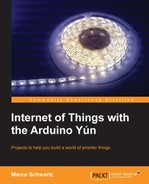Let's see what we learned in this project. At the beginning of the project, you saw how to interface the required components of this project to your Arduino Yún board: a relay module, a current sensor, and a lamp that will be controlled by the Yún board.
Then, we wrote a simple sketch to test the different components of the project and made sure that they all worked correctly.
Then, we built the energy consumption logging part of the project, and logged the power consumption inside a Google Docs spreadsheet. We also used the built-in capabilities of Google Docs to calculate the actual energy consumption, total energy cost, and on/off time of the device.
Finally, in the last part of the project, we built a graphical user interface to control the relay from a web browser, from your computer, or a smartphone/tablet.
Of course, there are many ways to take what you've learned in this project and extend it further. The first thing you can do is to add more devices to the project. For example, Arduino Yún has six analog inputs in total, so in theory you could plug the same number of current sensors into the Yún. Following the same principles, you could also add more Arduino Yún boards to the project.
You could also use the project with more features of Temboo, such as integrating the power measurements with social media, for example, by alerting the user with Twitter when the power consumption exceeds a given threshold. The user could then shut the lamp off by replying to this tweet.
In the next chapter, we will use other features of the Arduino Yún such as the USB port and the embedded Linux machine to create a wireless security camera. This camera will automatically upload pictures to a Dropbox folder and also stream the video live on YouTube so you can monitor your home remotely.
